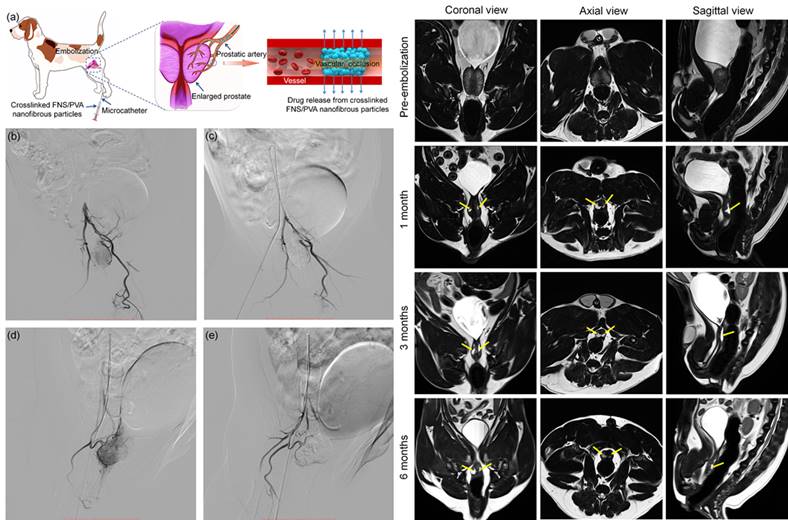Water-stable and finasteride-loaded polyvinyl alcohol nanofibrous particles with sustained drug release for improved prostatic artery embolization — in vitro and in vivo evaluation
Professor Yang Guang's team from School of Life and Professor Zhang Yaopeng's team from Donghua University
Prof. Wang Liang of the Department of Radiology, Tongji Hospital of Huazhong University of Science and Technology published the title of "Water-stable and Finasteride -loaded Polyvinyl alcohol nanocomposite with Structural Drug Release for Socialization of the fibrous particles" in the authoritative journal Materials Science and Engineering C
Prostatic alga (in vitro and in vivo evaluation).
Prostatic artery embolization is a minimally invasive, safe and effective interventional treatment technique. Currently, prostatic artery embolization is widely used in the treatment of benign prostatic hyperplasia, as well as to relieve various Lower Urinary tract symptoms (LUTS) such as frequent urination, urgency of urination, and Urinary obstruction.
In recent years, the artery Chemoembolization (Transarterial Chemoembolization, conventional TACE) has been gradually used in the treatment of various malignant tumor, its basic principle is to take medicine after embolization material targeted into diseased organ or tissue, along with physical thrombosis embolism materials can also slow release chemotherapy drugs, avoid the systemic side effects brought by the simple use of drugs and improve the bioavailability of drugs.
Thus, none of the medically loaded embolization agents are used to treat Benign Prostatic Hyperplasia (BPH).
Therefore, in this study, we loaded Finasteride (FNS) Polyvinyl alcohol (PVA) nanofiber films with blended electrostatic spinning technology, which was further applied to 150 & ORDM;
C was treated at high temperature to improve its water stability. Finally, nanofiber particles were prepared by liquid nitrogen grinding and screened.
The average diameter of the prepared FNS/PVA nanofibers was 272 m. The nanofibers were characterized by XRD, FTIR and TEM. The results all showed that FNS was crystallized in PVA nanofibers.
In addition, nanofibers have good cytocompatibility and blood compatibility, providing experimental support for further research in vivo.
Further through the beagle prostate hyperplasia model in vivo study was carried out, the results show that PVA and FNS/PVA nanofibers prostate blood-supply artery embolism particles can effectively embolism, 1, 3 and 6 months in embolism after prostate volume quantitative measurement results confirmed the FNS/PVA nanofibers rather than PVA fiber embolism nanoparticles can promote prostate olume reduction.
Further histological studies revealed cystic necrosis of the prostate and ischemic necrosis and fibrosis of the surrounding tissue after arterial embolization.
H&E staining of periprostate tissues (bladder, kidney, vas deferens, and rectum) showed no ectopic embolism.
The results show that FNS/PVA nanoparticles have good potential in the treatment of BPH, and provide a theoretical basis for the development of other types of drug-loading embolization agents.
The first unit of this paper is School of Life, Huazhong University of Science and Technology. The co-authors are Li Xiaohong, a doctoral student of School of Life, and Li Baosen, a doctor of Tongji Hospital. Corresponding authors are Professor Yang Guang, School of Life, Professor Zhang Yaopeng of Donghua University and Professor Wang Liang of Tongji Hospital.
This research was supported by the National Natural Science Foundation of China (21774039, 51603079, 31270150).
 论文链接:https://www.sciencedirect.com/search?qs=Water-stable%20and%20finasteride-loaded%20polyvinyl%20alcohol%20nanofibrous%20particles%20with%20sustained%20drug%20release%20for%20improved%20prostatic%20artery%20embolization%20%E2%80%94%20in%20vitro%20and%20in%20vivo%20evaluation
论文链接:https://www.sciencedirect.com/search?qs=Water-stable%20and%20finasteride-loaded%20polyvinyl%20alcohol%20nanofibrous%20particles%20with%20sustained%20drug%20release%20for%20improved%20prostatic%20artery%20embolization%20%E2%80%94%20in%20vitro%20and%20in%20vivo%20evaluation
DSA images of prostatic artery embolization and T2MRI images at 1,3, and 6 months